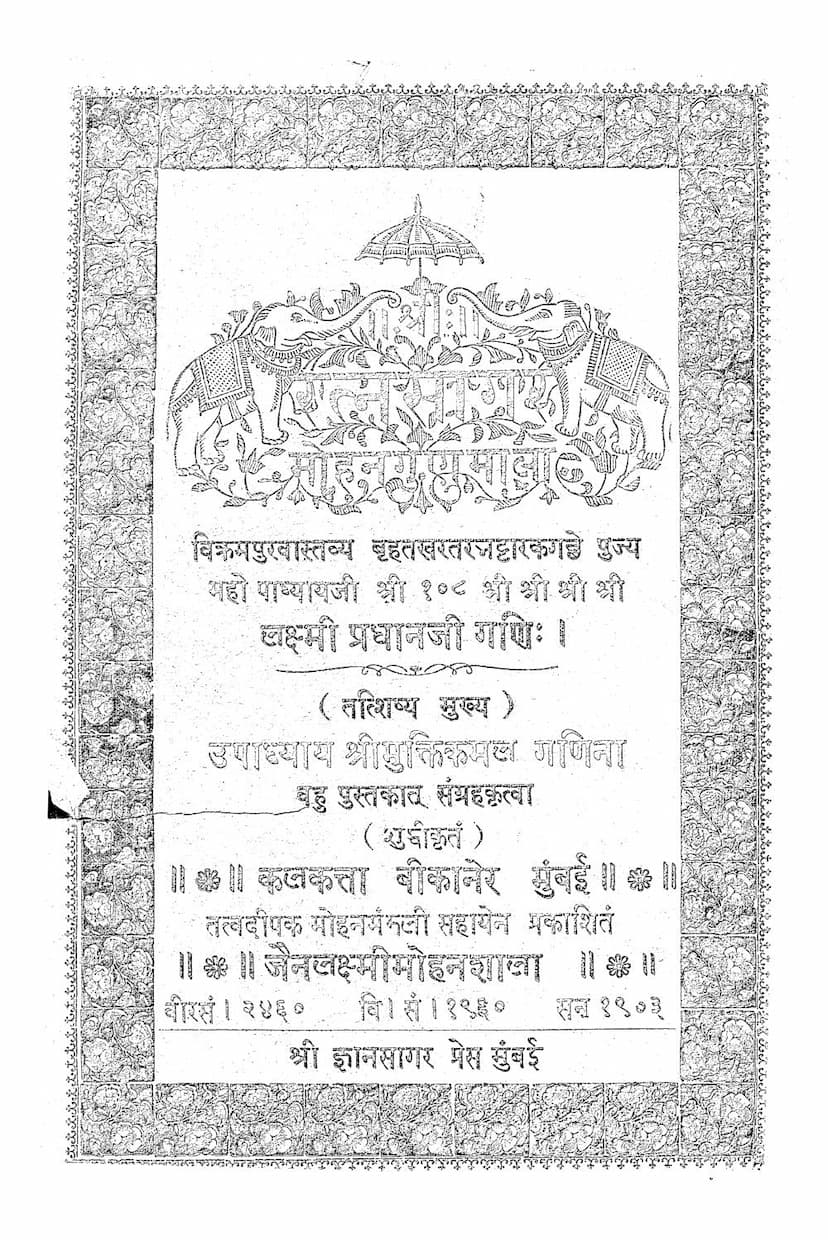Ratnasagar Mohan Gun Mala
Added to library: September 2, 2025

Summary
Here's a summary of the provided Jain text, "Ratnasagar Mohan Gun Mala," based on the extensive table of contents and passages provided:
Overall Summary:
"Ratnasagar Mohan Gun Mala" by Muktikamal Gani, published by Jain Lakshmi Mohan Shala, is a comprehensive collection of Jain devotional literature, rituals, prayers, and teachings. The text is organized into several sections, primarily focusing on the first volume ("प्रथम नाग"), which is extensively detailed in the provided table of क. It covers a wide range of topics essential for Jain practice and spiritual understanding, from foundational principles to specific rituals and prayers.
Key Sections and Content:
The provided text is a detailed index and partial content of the first volume, "Ratnasagar," which appears to be the primary part of the "Mohan Gun Mala." The catalog link confirms it's a volume from a larger collection. The index covers numerous chapters and sub-sections, indicating a highly structured and thorough treatment of Jain religious knowledge.
Here's a breakdown of the major themes and types of content found in the excerpt:
-
Praise and Invocation (Mangalacharan & Namaskar):
- The book begins with auspicious invocations (Mangalacharan) and salutations to the Panch Parameshthi (the five supreme beings in Jainism).
- It includes specific verses of praise for Lord Jinendra, Saraswati, and Guru Gautam Swami, highlighting their importance in spiritual learning and practice.
-
Alphabetical and Grammatical Foundations:
- The text includes sections on the Marathi alphabet (स्वर, व्यंजन, युक्तादि वर्ण माला), indicating a focus on the linguistic and scholarly aspects of Jain tradition, essential for understanding scriptures.
- It also touches upon grammatical rules and principles ("संधिसुत्र, सिधोवर्णः समाम्नायः").
-
Core Jain Principles and Practices:
- Pancha Parmeshthi: Frequent mentions and praises of the five supreme beings (Siddha, Arihant, Acharya, Upadhyaya, Sadhu) are evident throughout the text, emphasizing their central role in Jainism.
- Navkar Mantra: The significance and recitation of the Navkar Mantra are highlighted with various contexts and explanations ("नवकार मंत्र जयनसामि० प्रतिक्रमण सर्वपाठ," "नवकारस्यादि १० पञ्चकखाण").
- Pratikraman (Repentance/Confession): A significant portion of the text is dedicated to the rituals of Pratikraman, covering daily (Sandhyakal, Devshi), fortnightly (Pakkhi), quarterly (Choumasi), and annual (Samvatsari) procedures. It includes specific verses and guidelines for these ceremonies ("साधु प्रतिक्रमण," "श्रावक प्रतिक्रमण," "वंदित्तू सूत्र," "आलोयण, आजूणा").
- Panchakhan (Vows/Abstinence): The text details various types of vows and abstinence, including the "Dash Panchakkhan" (ten vows) and their explanations, which are crucial for lay practitioners ("दश पञ्चक्खाण आगारार्थः," "दश पञ्चक्खाण आगारसंख्या गाथा").
- Samayik (Meditation/Equanimity): Instructions and procedures for performing Samayik are provided, covering its various aspects and timings ("सामायक विधिः," "संध्याकाल सामायक ग्रहण विधिः," "प्रनात सामायक विधिः").
- Pausadh (Fasting/Celibacy): The text includes detailed instructions for observing Pausadh, a significant Jain vrata, covering day and night observances ("अठ पुहरी पोशह विधिः," "दिवश चौपुहरी पोसह विधिः," "रात्रि सबंधी चौपुहरी पोसह विधिः").
-
Devotional Literature and Hymns (Stotras/Stavans):
- A vast collection of hymns and prayers dedicated to various Tirthankaras and divine beings is present. This includes:
- Tirthankara Hymns: Numerous sections are dedicated to specific Tirthankaras like Rishabhnath, Ajitnath, Sambhavnath, Abhinandan, Sumatinath, Padmaprabhu, Suparshvanath, Chandranaprabha, Suvidhinath, Shitalnath, Shreyansnath, Vasupujya, Vimalnath, Anantanath, Dharmanath, Shantinath, Kunthunath, Aranatha, Mallinath, Munisuvrata, Neminath, Parshvanath, and Mahavir Swami. These are often presented as specific "Stotras" or "Stavans" related to their life events or attributes.
- Deva Vandana: Prayers and rituals for worshipping deities (like Kshetrapal, Sthana-devata) are also included.
- Specific Deities: There are mentions of prayers dedicated to Goddess Saraswati and other deities.
- Gurus and Ascetics: Praise for Gurus and Acharyas is a recurring theme, emphasizing their role as spiritual guides.
- A vast collection of hymns and prayers dedicated to various Tirthankaras and divine beings is present. This includes:
-
Wisdom Literature (Hitopadesh):
- The text incorporates sections of "Hitopadesh," which likely contains moral teachings, ethical guidelines, and wisdom literature relevant to Jain life.
-
Rituals and Ceremonies:
- Muhpatti Pamilehan: Procedures for cleaning the Muhpatti (a cloth worn by Jain monks and nuns to prevent accidental harm to microorganisms) are detailed, including specific verses to recite.
- Choumasi, Samvatsari, Pratikraman: As mentioned, detailed procedures for these significant Jain festivals and repentance rituals are included.
- Chaobis Thamil: References to rituals concerning the 24 Tirthankaras.
-
Cataloging and Structure:
- The "सूचीपत्र" (index) format is meticulously followed, with numbered entries for each "Stotra" or "Vidhi," listing the title and page number. This indicates a well-organized and reference-friendly text.
-
Author and Publisher:
- The author, Muktikamal Gani, and publisher, Jain Lakshmi Mohan Shala, are mentioned, placing the work within the Jain religious publishing landscape.
In essence, "Ratnasagar Mohan Gun Mala" is a comprehensive guide for Jain followers, providing them with the necessary scriptural knowledge, ritualistic procedures, and devotional content to lead a spiritual life according to Jain principles. The sheer number of listed items suggests a deep and broad coverage of Jain traditions, likely serving as a foundational text for study and practice within the Jain community.